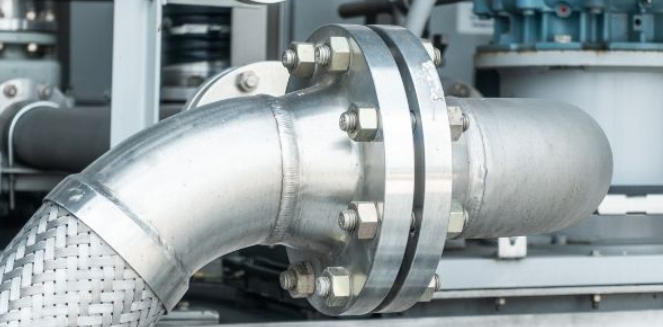The incidents of leaks caused by flange interface in petrochemical plants are continuously increasing, posing significant risks to the operation of the facilities. This article, through analyzing the causes of flange leaks, introduces the concept of flange management, proposes specific process control measures, and provides a reasonable method for calculating bolt tightening loads. The aim is to enhance the quality of flange installation and reduce the occurrence of flange leaks.
In petrochemical plants, process pipelines, like the blood vessels in the human body, are intricate and often carry toxic and hazardous substances. Ensuring the construction quality of pipelines becomes a focal point in engineering quality control. When discussing the quality of pipeline construction, welding quality may come to mind first. However, in petrochemical plants, besides welding connections, flange connections are extensively used for pressure pipelines. The number of flange bolts is large, and the operating conditions are complex. In recent years, incidents of leaks caused by flange interfaces have been on the rise. Approximately 18% of all leakage incidents are attributed to flange interface leaks. Therefore, controlling the quality of flange installation and strengthening flange management are particularly crucial.
Main Causes of Flange Leaks
There are various reasons for flange leaks, and during the construction phase, the main reasons for flange leaks are as follows:
1.Damage to sealing surfaces such as flanges and gaskets;
2.Incorrect use of gasket or bolt materials that do not meet the operational conditions of the pipeline;
3.Flange misalignment causing leaks;
4.Improper fastening causing gasket damage;
5.Insufficient fastening load, preventing the gasket from achieving sealing performance;
6.Excessive fastening load causing gasket failure.
Control Measures to Prevent Flange Leaks
In summary, to ensure that flanges do not leak, strict control procedures for flanges must be implemented to ensure the quality of flange and gasket installation. Additionally, appropriate fastening loads should be selected to ensure good sealing performance of the gasket. The following measures are introduced in terms of flange process management and bolt tightening load calculation.
2.1 Flange Process Management
2.1.1 Personnel Training and Management
All personnel involved in flange management must undergo certified training before working. Unauthorized operations are strictly prohibited, and training includes both theoretical and practical components.
2.1.2 Material Management
Material management includes the management of flanges, fasteners, and gaskets. All materials must undergo thorough inspection upon arrival to ensure their intrinsic quality. Specific requirements for material acceptance include having quality certification documents in accordance with design and specification requirements.
2.1.3 Equipment Selection
Different tightening equipment is used based on bolt specifications. Manual torque wrenches, electric torque wrenches, and hydraulic wrenches are commonly used. The torque should be applied in a step-by-step process to achieve the final required torque.
2.1.4 Flange Installation
Before flange installation, the sealing surface and gasket should be inspected to ensure there are no defects affecting sealing performance. Flange bolts should be installed in a consistent direction and exposed length.
2.1.5 Bolt Tightening
Flange connection bolts should be tightened symmetrically and gradually to achieve the final torque value. The tightening steps include hand tightening, 30% torque, 60% torque, and the final target torque.
2.2 Bolt tightening load calculation:
Choosing the appropriate tightening load is a key aspect of flange management. Currently, there is no unified, standard calculation method in domestic regulations and literature. Most provide a fixed tightening torque value, but the tightening torque should be a range. This is to ensure the flange connection achieves sealing performance and to prevent damage to gaskets and the failure or fracture of bolts.
Additionally, the bolt tightening torque is not a precise value. From the torque calculation formula: T=KFdT=KFd, where TT is torque, KK is the torque coefficient (generally taken as 0.1~0.2), FF is preload force, and dd is the nominal diameter of the bolt. The torque coefficient KK is a variable influenced by factors such as the smoothness of the thread engagement surface, the smoothness of the nut and flange end face, and whether lubrication is used. The variation in the torque coefficient has a significant impact on the torque value, so accurate calculation of the preload force is essential to reduce errors.
2.2.1 Calculating Preload Force Based on Gasket Performance:
Calculate the minimum load F_oFo required for tightening a single bolt according to the minimum clamping force of the gasket in the operating state. Formula: F_o = (F + F_p)/nFo=(F+Fp)/n, where FF is the total axial force caused by internal pressure in the operating state, F_pFp is the minimum gasket clamping force in the operating state, and nn is the number of bolts.
Calculate the minimum bolt load F_g1Fg1 required for tightening a single bolt in the preload state based on the minimum gasket clamping force. Formula: F_g1 = F_a/nFg1=Fa/n, where F_aFa is the minimum gasket clamping force in the preload state.
Calculate the maximum bolt load F_g2Fg2 required for tightening a single bolt based on the maximum allowable stress of the gasket. Formula: F_g2 = (S_g \times A_g)/nFg2=(Sg×Ag)/n, where S_gSg is the maximum allowable stress of the gasket, and A_gAg is the gasket sealing area.
2.2.2 Calculating Preload Force Based on Bolt Allowable Stress:
Calculate the minimum bolt load F_b1Fb1 and maximum bolt load F_b2Fb2 required for tightening a single bolt based on bolt allowable stress. Formulas: F_b1 = 0.25 \times R_{el} \times A_bFb1=0.25×Rel×Ab, F_b2 = 0.7 \times R_{el} \times A_bFb2=0.7×Rel×Ab, where R_{el}Rel is the yield strength of the bolt, and A_bAb is the bolt stress cross-sectional area.
2.2.3 Comprehensive Comparison:
Determine the minimum load F_{min}Fmin and maximum load F_{max}Fmax required for tightening a single bolt:
F_{min} = \max(F_o, F_g1, F_b1)Fmin=max(Fo,Fg1,Fb1)
F_{max} = \min(F_b2, F_g2)Fmax=min(Fb2,Fg2)
2.2.4 Calculate the Torque Range T_{min}Tmin and T_{max}Tmax:
T_{min} = k \times F_{min} \times dTmin=k×Fmin×d
T_{max} = k \times F_{max} \times dTmax=k×Fmax×d
2.3 Mass Process Control Key Points:
2.3.1 Pre-installation Inspection:
Check the cleanliness inside the pipe, damage to flange faces and gaskets, and verify that the bolt and gasket materials and specifications match the design drawings. For rusted flange sealing surfaces, manual tools like steel wire brushes can be used for rust removal, and cleaning agents can be used to remove stains. Severely damaged flange sealing surfaces should not be used. For inspection and maintenance devices, inspect the flange sealing surface after disassembly, and replace if damaged.
2.3.2 Quality Inspection After Flange Bolt Tightening:
After flange bolt tightening is completed, project quality inspectors perform spot checks on bolt torque and flange parallelism according to inspection records. Once approved, they sign and confirm.
2.3.3 Pressure Test Verification:
Pipeline pressure testing is a crucial method for inspecting flange sealing performance. During the pressure test, each flange’s sealing performance must be checked to ensure no leakage. The following points should be considered:
If leakage is detected, do not tighten under pressure. Identify and mark the leakage points, and address them after depressurization.
After depressurization, recheck the flange parallelism and bolt tightening torque. If the parallelism is not in compliance, loosen the bolts on the opposite side and readjust the flange parallelism. Follow the bolt tightening steps to ensure proper tightening. If only the bolt torque does not meet the requirements, tighten directly to the target torque.
After adjusting the flange, recheck the pressure test. The test is considered successful if there is no leakage. Mark the flange bolts again. If leakage persists, depressurize, open the flange, inspect the flange sealing surface and gasket, replace the gasket if necessary, and repair or replace the flange sealing surface. After eliminating defects, retest until verification is successful. Mark the flange bolts.
3 Conclusion:
Based on the theoretical and data analysis above, it is evident that pipeline flange management is a systematic engineering process. It involves considering various factors related to flange sealing effectiveness, including flange group alignment, sealing surface condition, gasket quality, proper use and torque control of bolts, and variations in process operating conditions. Effective risk mitigation of potential flange leaks can only be achieved through strict process control, enhanced material management, and precise control of tightening loads.

